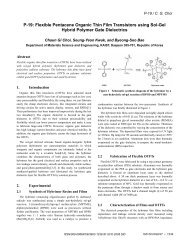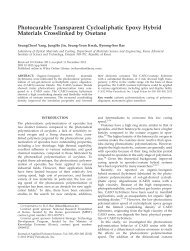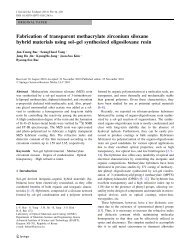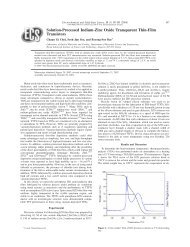A flexible moisture barrier comprised of a SiO2-embedded organicâ ...
A flexible moisture barrier comprised of a SiO2-embedded organicâ ...
A flexible moisture barrier comprised of a SiO2-embedded organicâ ...
Create successful ePaper yourself
Turn your PDF publications into a flip-book with our unique Google optimized e-Paper software.
Organic Electronics 14 (2013) 1435–1440<br />
Contents lists available at SciVerse ScienceDirect<br />
Organic Electronics<br />
journal homepage: www.elsevier.com/locate/orgel<br />
A <strong>flexible</strong> <strong>moisture</strong> <strong>barrier</strong> <strong>comprised</strong> <strong>of</strong> a SiO 2 -<strong>embedded</strong><br />
organic–inorganic hybrid nanocomposite and Al 2 O 3 for<br />
thin-film encapsulation <strong>of</strong> OLEDs<br />
Yun Cheol Han a , Eungtaek Kim a , Woohyun Kim a , Hyeon-Gyun Im b , Byeong-Soo Bae b ,<br />
Kyung Cheol Choi a,⇑<br />
a Department <strong>of</strong> Electrical Engineering, Korea Advanced Institute <strong>of</strong> Science and Technology, 291 Daehak-ro, Yuseong-gu, Daejeon 305-701, Republic <strong>of</strong> Korea<br />
b Department <strong>of</strong> Materials Science and Engineering, Korea Advanced Institute <strong>of</strong> Science and Technology, 291 Daehak-ro, Yuseong-gu, Daejeon 305-701,<br />
Republic <strong>of</strong> Korea<br />
article<br />
info<br />
abstract<br />
Article history:<br />
Received 18 January 2013<br />
Received in revised form 8 February 2013<br />
Accepted 3 March 2013<br />
Available online 29 March 2013<br />
Keywords:<br />
OLED<br />
Ca test<br />
Nanocomposite<br />
Moisture <strong>barrier</strong><br />
Encapsulation<br />
We demonstrated a high performance <strong>flexible</strong> multi-<strong>barrier</strong> containing a silica nanoparticle-<strong>embedded</strong><br />
organic–inorganic hybrid (S–H) nanocomposite and Al 2 O 3 . The multi-<strong>barrier</strong><br />
was prepared by low-temperature Al 2 O 3 atomic layer deposition and with a spin-coated<br />
S–H nanocomposite. The <strong>moisture</strong> <strong>barrier</strong> properties were investigated with a water vapor<br />
transmission rate (WVTR), estimated by a Ca test at 30 °C, 90% R.H.. Moisture diffusion was<br />
effectively suppressed by the sub-700 nm thick multi-<strong>barrier</strong> incorporating well-dispersed<br />
silica nanoparticles in the organic layer. A low WVTR <strong>of</strong> 1.14 10 5 g/m 2 day and average<br />
transmittance <strong>of</strong> 85.8% in the visible region were obtained for the multi-<strong>barrier</strong>. After<br />
bending under tensile stress mode, the <strong>moisture</strong> <strong>barrier</strong> property <strong>of</strong> the multi-<strong>barrier</strong>s<br />
was retained. The multi-<strong>barrier</strong> was successfully applied to thin-film encapsulation <strong>of</strong><br />
OLEDs. The thin-film encapsulated OLEDs showed practicable current–voltage–luminance<br />
(I–V–L) characteristics and stable real operation over 700 h under ambient conditions.<br />
Ó 2013 Elsevier B.V. All rights reserved.<br />
1. Introduction<br />
Since the first report <strong>of</strong> electroluminescent organic<br />
thin-films [1], the development <strong>of</strong> organic light-emitting<br />
diodes (OLEDs) has progressed rapidly. Flexible OLEDs<br />
are currently considered to be the most promising candidate<br />
for next-generation displays. One <strong>of</strong> the major obstacles<br />
to the realization <strong>of</strong> <strong>flexible</strong> OLEDs is reliable thin-film<br />
encapsulation <strong>of</strong> OLEDs. Due to sensitivity to <strong>moisture</strong> and<br />
oxygen, organic materials are easily oxidized and crystalized<br />
by exposure to external environment. These effects<br />
can directly lead to the formation <strong>of</strong> dark spots, which<br />
are known as non-emissive regions [2–4]. Burrows et al.<br />
reported a simple encapsulation method using glass and<br />
epoxy adhesive in a N 2 -filled glove box [5]. Based on this<br />
⇑ Corresponding author. Tel.: +82 42 350 3482; fax: +82 42 350 8082.<br />
E-mail address: kyungcc@kaist.ac.kr (K.C. Choi).<br />
encapsulation technique, glass-lid encapsulation is generally<br />
used with a desiccant such as BaO and CaO. However,<br />
the glass-lid is not suitable for <strong>flexible</strong> encapsulation due<br />
to its mechanically breakable nature. Furthermore, the<br />
water vapor transmission rate (WVTR) <strong>of</strong> the polymer substrate<br />
is substantially below the requirement for OLED<br />
applications (10 6 g/m 2 day) [6]. A thin-film <strong>barrier</strong> coating<br />
is essential for realizing reliable <strong>flexible</strong> OLEDs. Inorganic<br />
single <strong>barrier</strong>s [7,8] and inorganic nanolaminate<br />
<strong>barrier</strong>s [9,10] have shown potential to replace glass-lid<br />
encapsulation. Although these inorganic <strong>barrier</strong>s have<br />
low WVTR values, the formation <strong>of</strong> defects such as<br />
pinholes cannot be avoided due to the limitations <strong>of</strong> the<br />
vacuum deposition process. An organic–inorganic multi<strong>barrier</strong><br />
approach was reported as an alternative to prevent<br />
the formation <strong>of</strong> pinholes [11]. Multi-<strong>barrier</strong> encapsulation<br />
<strong>of</strong> OLEDs has demonstrated long lifetime comparable to<br />
that achieved with glass-lid encapsulation [12,13]. The<br />
1566-1199/$ - see front matter Ó 2013 Elsevier B.V. All rights reserved.<br />
http://dx.doi.org/10.1016/j.orgel.2013.03.008
1436 Y.C. Han et al. / Organic Electronics 14 (2013) 1435–1440<br />
permeation mechanisms <strong>of</strong> the multi-<strong>barrier</strong>s were<br />
discussed by Graff et al., on the basis <strong>of</strong> transient and<br />
steady-state vapor permeation analyses [14]. The multi<strong>barrier</strong>s<br />
delay permeation in the transient period rather<br />
than reducing the steady-state permeation rate. In the<br />
transient period, lag time is extremely increased due to<br />
the effectively long diffusion paths. Permeation is consequently<br />
delayed by up to few years. A multi-<strong>barrier</strong> design<br />
having a complicated diffusion path is crucial for the <strong>moisture</strong><br />
<strong>barrier</strong>.<br />
Here, we report an organic–inorganic <strong>flexible</strong> multi<strong>barrier</strong><br />
based on a solution-processed silica nanoparticle<strong>embedded</strong><br />
organic–inorganic hybrid (S–H) nanocomposite<br />
as an organic layer coupled with a low-temperature atomic<br />
layer deposited Al 2 O 3 layer. To reinforce the effects provided<br />
by the multi-<strong>barrier</strong> approach, we additionally introduced<br />
silica nanoparticles as filler into the multi-<strong>barrier</strong><br />
structure to create complicated diffusion paths. These <strong>barrier</strong>s<br />
resulted in a low WVTR value for a sub-700 nm thinfilm.<br />
We also discussed the <strong>barrier</strong> performance in terms <strong>of</strong><br />
optical transmittance and flexibility. Finally, we applied<br />
the multi-<strong>barrier</strong> to thin-film encapsulation <strong>of</strong> OLEDs.<br />
The passivated OLEDs showed identical current–voltage–<br />
luminance (I–V–L) characteristics and stable operation.<br />
2. Experimental<br />
2.1. Preparation <strong>of</strong> organic–inorganic hybrid nanocomposite<br />
In a previous study, we prepared a silica nanoparticle<strong>embedded</strong><br />
sol–gel organic–inorganic hybrid nanocomposite<br />
(S–H nanocomposite) to improve the <strong>moisture</strong> <strong>barrier</strong><br />
performance <strong>of</strong> a cyclo-aliphatic epoxy based hybrid material<br />
[15]. Nanopox Ò E600 (Nanoresins, Germany), based on<br />
methyl-terminated silica nanoparticles dispersed in a<br />
reactive diluent <strong>of</strong> 3,4-epoxycyclohexyl methyl 3,4-<br />
epoxycyclohexane carboxylate (EMEC) was mixed with<br />
UV-curable cycloaliphatic-epoxy hybrid materials (hybrimer),<br />
synthesized via a sol–gel reaction between [2-(3,4-<br />
epoxycyclohexyl)ethyl]trimethoxysilane (ECTS) and diphenylsilanediol<br />
(DPSD). Arylsulfoninum hexafluorophosphate<br />
salt was used as an initiator for photo-cationic polymerization.<br />
Propylene glycol monoether acetate was added as a<br />
solvent to control the thickness <strong>of</strong> the spin-coated layer.<br />
The details <strong>of</strong> the synthesis method and characteristics <strong>of</strong><br />
the hybrimer are provided in earlier studies [16]. We have<br />
also reported the average particle diameters and dispersion<br />
morphology <strong>of</strong> the S–H nanocomposite in relation to<br />
silica content. For 100% silica content, the nanoparticles,<br />
which have an average diameter <strong>of</strong> 19 nm, were homogeneously<br />
dispersed in the oligosiloxane resin. The optimized<br />
S–H nanocomposite showed high transmittance and a low<br />
WVTR value due to the relatively low degree <strong>of</strong> light scattering<br />
and extended diffusion paths <strong>of</strong> <strong>moisture</strong> compared<br />
to those observed with low silica contents, respectively.<br />
2.2. Ca test<br />
The WVTR value was estimated by a Ca test, which is<br />
based on the electrical corrosion <strong>of</strong> the Ca layer [17]. The<br />
Ca sensor was prepared by thermal evaporation <strong>of</strong> a Ca<br />
layer on a glass substrate. The Ca layer had an area <strong>of</strong><br />
1.5 cm 2 and a height <strong>of</strong> 250 nm. The window area for permeation<br />
was identical to that <strong>of</strong> the Ca layer. An Al layer <strong>of</strong><br />
100-nm thickness was deposited as an electrode. 100-lm<br />
thick PET was employed as a substrate for the <strong>barrier</strong> coating<br />
throughout the experiment. The Ca sensor was encapsulated<br />
by the <strong>barrier</strong>-coated film using a UV-curable<br />
sealant. To ensure encapsulation <strong>of</strong> the Ca layer, a thin line<br />
<strong>of</strong> sealant was applied from a syringe along the sealing line<br />
by a dispenser. The width <strong>of</strong> the sealing line was 2.5 mm. A<br />
glass-lid with a hole at the center was used to support the<br />
<strong>barrier</strong>-coating film. To apply pressure on the sealing line,<br />
the Ca sensor was clamped to the large glass substrate<br />
while UV-curing was performed. The entire process was<br />
conducted in a N 2 -filled glove box, which was integrated<br />
with a thermal evaporator. During degradation <strong>of</strong> the Ca<br />
sensor in the climate chamber at 30 °C and 90% R.H., the<br />
resistance <strong>of</strong> the sensor was monitored in situ using the<br />
four-point probe system.<br />
2.3. Barrier coating and device fabrication<br />
For the multi-<strong>barrier</strong> structure, the S–H nanocomposite<br />
and Al 2 O 3 were used as an organic and inorganic layer,<br />
respectively. Al 2 O 3 was deposited using a thermal ALD system.<br />
Trimethylaluminum (TMA) and H 2 O were used as a<br />
precursor and reactant, respectively. One cycle for Al 2 O 3<br />
consists <strong>of</strong> a TMA pulse, TMA purge, H 2 O pulse, and H 2 O<br />
purge successively. Nitrogen gas was used as both the carrier<br />
and purge gas. Pulse and purge sequences <strong>of</strong> 0.2–10 s<br />
were used and the temperature <strong>of</strong> the main chamber was<br />
maintained at 70 °C during the deposition process. The<br />
S–H nanocomposite with a predetermined amount <strong>of</strong> diluent<br />
was spin-coated at 4500 RPM for 5 s and subsequently<br />
UV-cured by I-line UV light (k = 365 nm, optical power<br />
density = 20 mW/cm 2 ) for 100 s. The thickness <strong>of</strong> the<br />
spin-coated S–H nanocomposite was around 190 nm, measured<br />
by a surface pr<strong>of</strong>iler (Dektak-8, Veeco, USA). Following<br />
the spin-coating process, the <strong>barrier</strong>-coated film was<br />
dried in a vacuum chamber with a high purity N 2 gas flow<br />
(99.9999%, 100 sccm) for 30 min to remove the remaining<br />
solvent. While drying the sample, the vacuum level <strong>of</strong> the<br />
chamber was maintained at 1.2 Torr. These organic and<br />
inorganic layers were coated on a 100-lm thick PET substrate,<br />
alternately.<br />
The OLEDs were fabricated on a glass substrate in a<br />
bottom-emission type. The OLED devices had a structure<br />
<strong>of</strong> ITO(150 nm)/2-TNATA(60 nm)/NPB(30 nm)/Alq 3 doped<br />
with C545t(35 nm)/Alq 3 (30 nm)/Liq(0.8 nm)/Al(100 nm),<br />
wherein 4,4 0 ,4 00 -tris(2-naphthylphenyl-phenylamino)-<br />
triphenylamine (2-TNATA) and N,N 0 -bis(1-naphthyl)-N,N 0 -<br />
diphenyl-1,1 0 -biphenyl – 4,4 0 -diamine (NPB) respectively<br />
functioned as a hole-injection layer (HIL) and a hole-transport<br />
layer (HTL). The emitting layer was co-deposited with<br />
tris(8-hydroxyquinolinato)aluminum (Alq 3 ) and 10-(2-<br />
benzothiazolyl)-2,3,6,7- (C545t) at 2% as a green emission<br />
dopant. Alq 3 was subsequently used as an electron<br />
transport layer (ETL). 8-Hydroxyquinolinolato-lithium<br />
(Liq) and Al were used as an electron-injection layer (EIL)<br />
and as the cathode, respectively. The devices were
Y.C. Han et al. / Organic Electronics 14 (2013) 1435–1440 1437<br />
encapsulated using a glass lid with a desiccant in a nitrogen<br />
globe box in the reference device. For thin-film encapsulation<br />
(TFE) <strong>of</strong> OLEDs, the multi-<strong>barrier</strong> was directly<br />
coated on the devices with an identical <strong>barrier</strong> coating<br />
method. The I–V–L characteristics were measured with a<br />
source meter (Keithley 2400, USA) and a spectrophotometer<br />
(CS-2000, Konica Minolta, Japan). The lifetime was recorded<br />
by Si-photo diodes (Polaronix M6000S, McScience,<br />
Korea).<br />
3. Results and discussion<br />
3.1. Permeation <strong>barrier</strong> properties <strong>of</strong> the multi-<strong>barrier</strong><br />
Permeation <strong>barrier</strong> properties <strong>of</strong> the S–H nanocomposite<br />
and Al 2 O 3 were characterized by the Ca test. The results <strong>of</strong><br />
the Ca test are plotted as normalized conductance vs. time<br />
curves and shown in Fig. 1. WVTR values <strong>of</strong> 0.58 g/m 2 day<br />
and 7.94 10 4 g/m 2 day were observed for the S–H<br />
nanocomposite and Al 2 O 3 , respectively. These values were<br />
estimated from the relation between the WVTR and slope<br />
<strong>of</strong> the curve [17].<br />
The normalized conductance curve for the glass-lid<br />
encapsulation <strong>of</strong> the Ca sensor is illustrated in Fig. 2a. To<br />
evaluate the long term stability <strong>of</strong> the sealing method described<br />
in Section 2.2, a Ca test was carried out over<br />
72 days. After WVTR measurement, the sample was stored<br />
Fig. 2. Results <strong>of</strong> WVTR measurements: (a) Glass-lid encapsulation <strong>of</strong><br />
the Ca sensor, and (b) multi-<strong>barrier</strong> encapsulation <strong>of</strong> the Ca sensor with<br />
an increase <strong>of</strong> the <strong>barrier</strong> stacks. Insets show a photograph <strong>of</strong> the<br />
encapsulated Ca sensor with a glass and a cross-sectional SEM image <strong>of</strong><br />
the multi-<strong>barrier</strong> on a Si substrate, respectively.<br />
Fig. 1. Ca test results <strong>of</strong> (a) 190-nm thick S–H nanocomposite and (b)<br />
330-cycles Al 2 O 3 on the 100-lm thick PET substrate. Insets show a<br />
photograph and schematic diagram <strong>of</strong> a Ca test sample, respectively.<br />
under ambient conditions for 5 months. The photograph in<br />
the inset <strong>of</strong> Fig. 2a shows that the initial conditions <strong>of</strong> the<br />
Ca layer were fully maintained. Among the three samples<br />
encapsulated by a glass-lid, the lowest WVTR value,<br />
2.96 10 6 g/m 2 day, was recorded with a 0.985% change<br />
in conductance after 72 days. The WVTR <strong>of</strong> the multi<strong>barrier</strong><br />
was also measured with application <strong>of</strong> an identical<br />
sealing method while varying the multi-<strong>barrier</strong> stacks, as<br />
shown in Fig. 2b. One dyad was composed <strong>of</strong> Al 2 O 3 (330<br />
cycles)/S–H nanocomposite resin (190 nm). The multi<strong>barrier</strong><br />
stacks were composed <strong>of</strong> 1.5 dyads to 3.5 dyads<br />
by depositing an Al 2 O 3 layer as a top layer. The lowest<br />
WVTR values were determined to be 1.14 10 4 g/m 2<br />
day, 5.43 10 5 g/m 2 day, and 1.14 10 5 g/m 2 day for<br />
each multi-<strong>barrier</strong> stack, respectively. The inset in Fig. 2b<br />
depicts a scanning electron microscope (SEM) image <strong>of</strong><br />
the 3.5 dyads multi-<strong>barrier</strong> on a Si wafer. The image was<br />
taken using a FEI Company instrument (Magellan400,<br />
USA). Each layer was well defined in the multi-<strong>barrier</strong> configuration.<br />
Sub-700 nm thickness was observed to be in the<br />
entire <strong>barrier</strong> structure.<br />
To ensure reproducibility and reliability <strong>of</strong> the multi<strong>barrier</strong><br />
performance, the WVTR measurement was evaluated<br />
for three samples <strong>of</strong> each multi-<strong>barrier</strong> stack. The<br />
resistance <strong>of</strong> each sample was monitored for more than<br />
10 days. The average WVTR values <strong>of</strong> the measurements<br />
are shown in Fig. 3. The WVTR values decreased as the
1438 Y.C. Han et al. / Organic Electronics 14 (2013) 1435–1440<br />
Fig. 3. The average WVTR values as a function <strong>of</strong> the multi-<strong>barrier</strong> stacks<br />
and the glass. Each sample was measured three times. The average WVTR<br />
value is indicated as a black box with maximum and minimum values.<br />
multi-<strong>barrier</strong> stack was increased. The average WVTR<br />
values were calculated to be 1.6 10 4 g/m 2 day, 7.07 <br />
10 5 g/m 2 day, and 1.26 10 5 g/m 2 day as the multi<strong>barrier</strong><br />
stacks were increased from 1.5 dyads to 3.5 dyads.<br />
For the glass-lid encapsulated Ca sensor, the average WVTR<br />
value was 3.54 10 6 g/m 2 day. The lower limit <strong>of</strong> the Ca<br />
test almost reached a WVTR <strong>of</strong> 10 6 g/m 2 day at 30 °C,<br />
90% R.H. in our experimental conditions. The variation <strong>of</strong><br />
the WVTR values for the same multi-<strong>barrier</strong> structure<br />
showed reasonable values.<br />
3.2. Bending characteristics <strong>of</strong> the multi-<strong>barrier</strong><br />
Fig. 4. Ca test results after bending test while varying the multi-<strong>barrier</strong><br />
stacks; (a) Normalized conductance versus time curve after 100 iterations<br />
<strong>of</strong> bending, and (b) comparison <strong>of</strong> the WVTR values after bending test.<br />
The inset shows a photograph <strong>of</strong> the bending test set-up.<br />
To identity the multi-<strong>barrier</strong>’s resistivity to bending<br />
stress, the bending test was conducted with a custommade<br />
bending machine, as shown in the inset <strong>of</strong> Fig. 4a.<br />
Tensile stress was applied to the multi-<strong>barrier</strong> with a bending<br />
radius <strong>of</strong> 3 cm. Fig. 4a presents the results <strong>of</strong> the WVTR<br />
measurement after 100 iterations <strong>of</strong> bending at a bending<br />
speed <strong>of</strong> 0.5 Hz. The WVTR was estimated to be<br />
2.23 10 4 g/m 2 day, 6.97 10 5 g/m 2 day, and<br />
1.76 10 5 g/m 2 day for 1.5 dyads, 2.5 dyads, and 3.5<br />
dyads, respectively. As shown in Fig. 4b, the WVTR values<br />
after the bending test were comparable to those before<br />
bending test.<br />
3.3. Optical properties <strong>of</strong> the multi-<strong>barrier</strong><br />
The optical transmittance for the normal incidence light<br />
was measured using a spectrophotometer (UV-2550,<br />
Shimadzu, Japan). The air was estimated as a baseline. All<br />
the <strong>barrier</strong>-coated samples on PET showed optical transmittance<br />
<strong>of</strong> above 80% in the wavelength region from<br />
400 nm to 900 nm, as illustrated in Fig. 5. The average<br />
transmittance in the visible region (k = 400–700 nm) for<br />
the 3.5 dyads multi-<strong>barrier</strong> was measured to be 85.8%.<br />
The inset in Fig. 5 shows a photograph <strong>of</strong> the logo images.<br />
The images in the square region indicated by the red<br />
dashed line are under the 3.5 dyads multi-<strong>barrier</strong> film.<br />
These images are almost identical to the original image<br />
owing to the high transmittance <strong>of</strong> the multi-<strong>barrier</strong>.<br />
Fig. 5. Optical transmittance <strong>of</strong> the multi-<strong>barrier</strong> with different stacks. In<br />
the photograph <strong>of</strong> the logo images, the red-dashed region shows the logo<br />
images under the multi-<strong>barrier</strong> film and the others are original images.<br />
3.4. Thin-film encapsulation <strong>of</strong> OLEDs<br />
A2mm 2 mm active area <strong>of</strong> the OLED was defined by<br />
crossing the cathode and anode electrode. A photo resist<br />
was used as an insulator, which allows the charge to flow<br />
only through the active area, as shown in the inset <strong>of</strong><br />
Fig. 6a. Fig. 6 shows the I–V–L characteristics <strong>of</strong> the thinfilm<br />
encapsulated OLED and a glass-lid encapsulated OLED<br />
with a desiccant. Both devices showed diode characteristics<br />
in the current density versus voltage curve, as illustrated<br />
in Fig. 6a. The devices had a turn-on voltage <strong>of</strong>
Y.C. Han et al. / Organic Electronics 14 (2013) 1435–1440 1439<br />
Fig. 7. Comparison <strong>of</strong> the lifetime with an initial luminance <strong>of</strong> 600 cd/m 2<br />
under ambient conditions. The inset shows 2 mm 2 mm microscope<br />
images <strong>of</strong> the active area before and after driving, respectively.<br />
Fig. 6. (a) A comparison <strong>of</strong> I–V characteristics between the thin-film<br />
encapsulated device and glass-lid encapsulated device. (b) Plot <strong>of</strong> the<br />
luminance versus current density. Insets show a schematic diagram and<br />
photograph <strong>of</strong> passivated OLEDs, respectively.<br />
around 2.5 V. The dc-current sweep measurement showed<br />
that the luminance values linearly increased. The maximum<br />
luminance level was measured to be around<br />
58,000 cd/m 2 at a current density <strong>of</strong> 382 mA/cm 2 . These results<br />
indicate that the two devices show almost identical<br />
operation.<br />
To verify the performance <strong>of</strong> the multi-<strong>barrier</strong> for thinfilm<br />
encapsulation <strong>of</strong> OLEDs, a lifetime test was carried out.<br />
The devices were operated by a constant current source <strong>of</strong><br />
0.15 mA under ambient conditions. The relative light<br />
intensity was calculated using a calibrated Si-photo diode<br />
with an initial luminance value <strong>of</strong> L 0 = 600 cd/m 2 . The error<br />
<strong>of</strong> the initial luminance value was less than 20 cd/m 2 .Itis<br />
known that the luminance degradation in OLEDs shows<br />
stretched exponential decay behavior under constant current<br />
driving [18]. The light intensity exponentially decreased<br />
over time for the two devices. After 720 h <strong>of</strong><br />
driving for the two devices, the luminance <strong>of</strong> the OLEDs reduced<br />
to 55.2% <strong>of</strong> the initial value for the glass-lid encapsulated<br />
device and 50.5% <strong>of</strong> the initial value for the thin-film<br />
encapsulated device, respectively. The microscope images<br />
<strong>of</strong> the active area for the thin-film encapsulated device,<br />
presented in the inset <strong>of</strong> Fig. 7, suggest that the OLED<br />
was successfully passivated without dark spots and did<br />
not degrade by external factors during real operation.<br />
We discussed the characteristics <strong>of</strong> a high performance<br />
multi-<strong>barrier</strong>. In the case <strong>of</strong> single inorganic <strong>barrier</strong>s, permeation<br />
<strong>of</strong> <strong>moisture</strong> is dominantly affected by the defects<br />
density [19]. A vacuum-deposited inorganic layer has<br />
intrinsic and extrinsic defects caused by imperfections <strong>of</strong><br />
the deposition process and the presence <strong>of</strong> impurities on<br />
the substrate, respectively. These defects function as permeation<br />
paths. They can be blocked by introducing an organic<br />
layer. In the organic–inorganic multi-<strong>barrier</strong><br />
approach, lag times are remarkably extended by adding organic–inorganic<br />
dyads due to suppression <strong>of</strong> diffusion,<br />
which is the slowest and the most critical step in the permeation<br />
process [14]. Because nan<strong>of</strong>illers in the polymer<br />
matrix force <strong>moisture</strong> to detour around the fillers in this<br />
layer, the <strong>barrier</strong> property can be enhanced by the tortuous<br />
diffusion path [20]. In this regard, the enhancement <strong>of</strong> the<br />
<strong>moisture</strong> <strong>barrier</strong> property is primarily attributed to extended<br />
diffusion paths. The experiments verified that the<br />
diffusion <strong>of</strong> <strong>moisture</strong> is effectively inhibited by organic–<br />
inorganic dyads in the multi-<strong>barrier</strong>. The diffusion path<br />
in the organic layer <strong>of</strong> the multi-<strong>barrier</strong> is complicated by<br />
the silica nanoparticles, which serve as the filler in the<br />
cyclo-aliphatic epoxy oligosiloxane resin (hybrimer).<br />
Consequently, a low WVTR value <strong>of</strong> 1.14 10 5 g/m 2 day<br />
was achieved for the 3.5 dyad multi-<strong>barrier</strong> with sub-<br />
700 nm overall thickness. The organic layer also functioned<br />
as a buffer layer for the bending stress. The <strong>moisture</strong><br />
<strong>barrier</strong> property was retained after a bending test with a<br />
bending radius <strong>of</strong> 3 cm.<br />
4. Conclusion<br />
We have investigated the characteristics <strong>of</strong> a high performance<br />
<strong>flexible</strong> multi-<strong>barrier</strong> consisting <strong>of</strong> the S–H nanocomposite<br />
and Al 2 O 3 as an organic and inorganic layer,<br />
respectively. The <strong>moisture</strong> <strong>barrier</strong> property was characterized<br />
through a Ca test, optimized with the sealing method<br />
<strong>of</strong> the Ca sensor. The Ca test showed a low limit <strong>of</strong><br />
2.96 10 6 g/m 2 day and favorable reproducibility over a<br />
long time. The sub-700 nm thick multi-<strong>barrier</strong> showed a<br />
low WVTR and high transmittance. After a bending test<br />
with a bending radius <strong>of</strong> 3 cm, the WVTR value did not<br />
significantly change. This multi-<strong>barrier</strong> was successfully<br />
applied to thin-film encapsulation <strong>of</strong> OLEDs. The encapsulated<br />
OLEDs comparable performance to that <strong>of</strong> glass-lid<br />
encapsulated OLEDs.
1440 Y.C. Han et al. / Organic Electronics 14 (2013) 1435–1440<br />
Acknowledgements<br />
This research was supported by Basic Science Research<br />
Program through the National Research Foundation <strong>of</strong><br />
Korea (NRF) funded by the Ministry <strong>of</strong> Education, Science<br />
and Technology (CAFDC-20120000820). This work was also<br />
supported by the Global Leading Technology Program <strong>of</strong><br />
the Office <strong>of</strong> Strategic R&D Planning (OSP) funded by the<br />
Ministry <strong>of</strong> Knowledge Economy, Republic <strong>of</strong> Korea<br />
(10042412).<br />
References<br />
[1] C.W. Tang, S.A. VanSlyke, Applied Physics Letters 51 (1987) 913.<br />
[2] S.F. Lim, W. Wang, S.J. Chua, Materials Science and Engineering: B 85<br />
(2001) 154.<br />
[3] S. Gardonio, L. Gregoratti, P. Melpignano, L. Aballe, V. Biondo, R.<br />
Zamboni, M. Murgia, S. Caria, M. Kiskinova, Organic Electronics 8<br />
(2007) 37.<br />
[4] L. Ke, S.-J. Chua, K. Zhang, N. Yakovlev, Applied Physics Letters 80<br />
(2002) 2195.<br />
[5] P.E. Burrows, V. Bulovic, S.R. Forrest, L.S. Sapochak, D.M. McCarty,<br />
M.E. Thompson, Applied Physics Letters 65 (1994) 2922.<br />
[6] J. Lewis, Materials Today 9 (2006) 38.<br />
[7] P.F. Carcia, R.S. McLean, M.H. Reilly, M.D. Groner, S.M. George,<br />
Applied Physics Letters 89 (2006) 031915.<br />
[8] P. Mandlik, J. Gartside, L. Han, I.-C. Cheng, S. Wagner, J.A. Silvernail,<br />
R.-Q. Ma, M. Hack, J.J. Brown, Applied Physics Letters 92 (2008)<br />
103309.<br />
[9] J.-H. Choi, Y.-M. Kim, Y.-W. Park, T.-H. Park, J.-W. Jeong, H.-J. Choi,<br />
E.-H. Song, J.-W. Lee, C.-H. Kim, B.-K. Ju, Nanotechnology 21 (2010)<br />
475203.<br />
[10] J. Meyer, D. Schneidenbach, T. Winkler, S. Hamwi, T. Weimann, P.<br />
Hinze, S. Ammermann, H.-H. Johannes, T. Riedl, W. Kowalsky, APL:<br />
Organic Electronics and Photonics 2 (2009) 157.<br />
[11] M.S. Weaver, L.A. Michalski, K. Rajan, M.A. Rothman, J.A. Silvernail,<br />
J.J. Brown, P.E. Burrows, G.L. Graff, M.E. Gross, P.M. Martin, M. Hall,<br />
E. Mast, C. Bonham, W. Bennett, M. Zumh<strong>of</strong>f, Applied Physics Letters<br />
81 (2002) 2929.<br />
[12] Y.C. Han, C. Jang, K.J. Kim, K.C. Choi, K. Jung, B.-S. Bae, Organic<br />
Electronics 12 (2011) 609.<br />
[13] Y.G. Lee, Y.-H. Choi, I.S. Kee, H.S. Shim, Y. Jin, S. Lee, K.H. Koh, S. Lee,<br />
Organic Electronics 10 (2009) 1352.<br />
[14] G.L. Graff, R.E. Williford, P.E. Burrows, Journal <strong>of</strong> Applied Physics 96<br />
(2004) 1840.<br />
[15] J. Jin, J.J. Lee, B.-S. Bae, S.J. Park, S. Yoo, K. Jung, Organic Electronics 13<br />
(2012) 53.<br />
[16] K. Jung, J.-Y. Bae, S.J. Park, S. Yoo, B.-S. Bae, Journal <strong>of</strong> Material<br />
Chemistry 21 (2011) 1977.<br />
[17] R. Paetzold, A. Winnacker, D. Henseler, V. Cesari, K. Heuser, Review<br />
<strong>of</strong> Scientific Instruments 74 (2003) 5147.<br />
[18] C. Féry, B. Racine, D. Vaufrey, H. Doyeux, S. Cinà, Applied Physics<br />
Letters 87 (2005) 213502.<br />
[19] A.S.da S. Sobrinho, G. Czeremuszkin, M. Latreche, M.R. Wertheimer,<br />
Journal <strong>of</strong> Vacuum Science & Technology A: Vacuum, Surfaces, and<br />
Films 18 (2000) 149.<br />
[20] R.K. Bharadwaj, Macromolecules 34 (2001) 9189.







